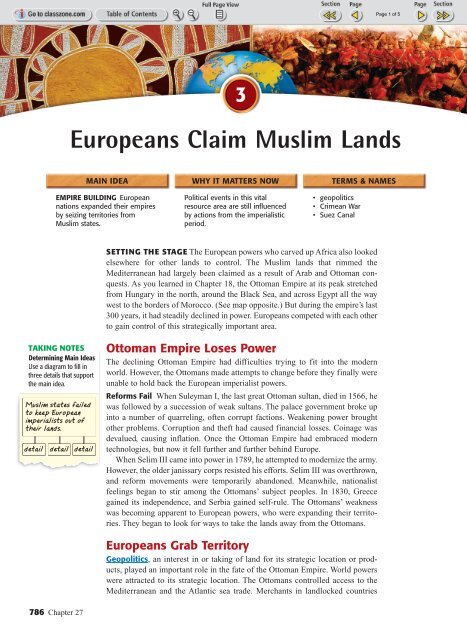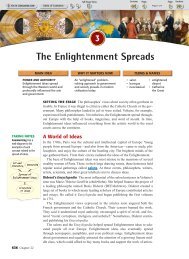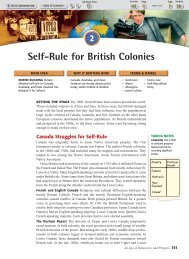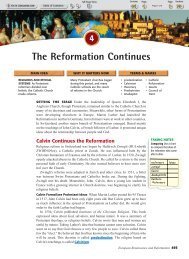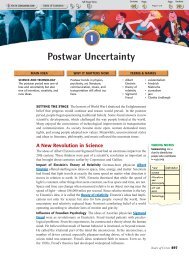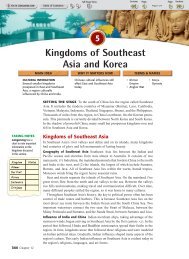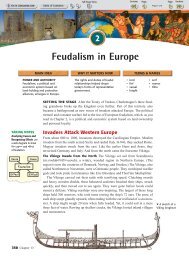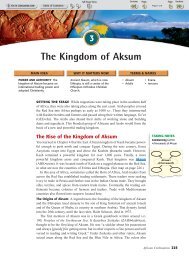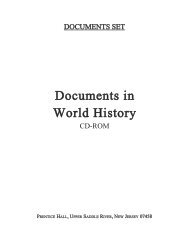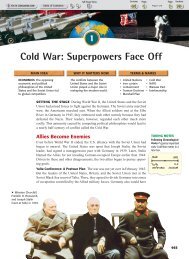Create successful ePaper yourself
Turn your PDF publications into a flip-book with our unique Google optimized e-Paper software.
<strong>Europeans</strong> <strong>Claim</strong> <strong>Muslim</strong> <strong>Lands</strong>3MAIN IDEA WHY IT MATTERS NOW TERMS & NAMESEMPIRE BUILDING Europeannations expanded their empiresby seizing territories from<strong>Muslim</strong> states.Political events in this vitalresource area are still influencedby actions from the imperialisticperiod.• geopolitics• Crimean War• Suez CanalSETTING THE STAGE The European powers who carved up Africa also lookedelsewhere for other lands to control. The <strong>Muslim</strong> lands that rimmed theMediterranean had largely been claimed as a result of Arab and Ottoman conquests.As you learned in Chapter 18, the Ottoman Empire at its peak stretchedfrom Hungary in the north, around the Black Sea, and across Egypt all the waywest to the borders of Morocco. (See map opposite.) But during the empire’s last300 years, it had steadily declined in power. <strong>Europeans</strong> competed with each otherto gain control of this strategically important area.TAKING NOTESDetermining Main IdeasUse a diagram to fill inthree details that supportthe main idea.<strong>Muslim</strong> states failedto keep Europeanimperialists out oftheir lands.detaildetaildetailOttoman Empire Loses PowerThe declining Ottoman Empire had difficulties trying to fit into the modernworld. However, the Ottomans made attempts to change before they finally wereunable to hold back the European imperialist powers.Reforms Fail When Suleyman I, the last great Ottoman sultan, died in 1566, hewas followed by a succession of weak sultans. The palace government broke upinto a number of quarreling, often corrupt factions. Weakening power broughtother problems. Corruption and theft had caused financial losses. Coinage wasdevalued, causing inflation. Once the Ottoman Empire had embraced moderntechnologies, but now it fell further and further behind Europe.When Selim III came into power in 1789, he attempted to modernize the army.However, the older janissary corps resisted his efforts. Selim III was overthrown,and reform movements were temporarily abandoned. Meanwhile, nationalistfeelings began to stir among the Ottomans’ subject peoples. In 1830, Greecegained its independence, and Serbia gained self-rule. The Ottomans’ weaknesswas becoming apparent to European powers, who were expanding their territories.They began to look for ways to take the lands away from the Ottomans.<strong>Europeans</strong> Grab TerritoryGeopolitics, an interest in or taking of land for its strategic location or products,played an important role in the fate of the Ottoman Empire. World powerswere attracted to its strategic location. The Ottomans controlled access to theMediterranean and the Atlantic sea trade. Merchants in landlocked countries786 Chapter 27
MakingInferencesHow did theCrimean War helplead to the declineof the OttomanEmpire?that lay beyond the Black Sea had to go through Ottoman lands. Russia, for example,desperately wanted passage for its grain exports across the Black Sea and intothe Mediterranean Sea. This desire strongly influenced Russia’s relations with theOttoman Empire. Russia attempted to win Ottoman favor, formed alliances withOttoman enemies, and finally waged war against the Ottomans. Discovery of oilin Persia around 1900 and in the Arabian Peninsula after World War I focusedeven more attention on the area.Russia and the Crimean War Each generation of Russian czars launched a war onthe Ottomans to try to gain land on the Black Sea. The purpose was to give Russiaa warm-weather port. In 1853, war broke out between the Russians and theOttomans. The war was called the Crimean War, after a peninsula in the Black Seawhere most of the war was fought. Britain and France wanted to prevent theRussians from gaining control of additional Ottoman lands. So they entered the waron the side of the Ottoman Empire. The combined forces of the Ottoman Empire,Britain, and France defeated Russia. The Crimean War was the first war in whichwomen, led by Florence Nightingale, established their position as army nurses. Itwas also the first war to be covered by newspaper correspondents.The Crimean War revealed the Ottoman Empire’s military weakness. Despitethe help of Britain and France, the Ottoman Empire continued to lose lands. TheRussians came to the aid of Slavic people in the Balkans who rebelled against theOttomans. The Ottomans lost control of Romania, Montenegro, Cyprus, Bosnia,Herzegovina, and an area that became Bulgaria. The Ottomans lost land in Africatoo. By the beginning of World War I, the Ottoman Empire was reduced in size andin deep decline.ATLANTICOCEAN0 500 MilesOttoman Empire,1699–1914SPAIN0 1,000 Kilometers0°FRANCEALGERIA(to France1830)MOROCCO(to France1912)(to Austria1699, 1878)ITALYBALKANS(independent1817, 1913)TUNISIA(to France1881)Mediterranean SeaTRIPOLI(to Italy1912)AUSTRIAALBANIAHUNGARYSERBIAROMANIAGREECEBULGARIARUSSIA(to Russia1783)Black SeaConstantinople(Istanbul)Cyprus(to Britain1878)EGYPT(partiallyindependent1841)CRIMEAANATOLIA40° ESYRIA(to Russia1803, 1829)M esopotamiaARABIAOttoman Empire at itsgreatest extent in 1699Ottoman Empire in 1914Territory becomespart ofCaspian SeaPersian Gulf40° NAZERBAIJAN(independent1730)PERSIARed SeaMeccaTropic of CancerGEOGRAPHY SKILLBUILDER: Interpreting Maps1. Region Approximately how much of the Ottoman Empire was lost by 1914?2. Region How many European nations claimed parts of the Ottoman Empire?Which areas became independent?787
▼ Muhammad Aliwas a commonsoldier who roseto leadership as aresult of his militaryskill and politicalshrewdness.788 Chapter 27The Great Game For much of the 19th century, Great Britain and Russia engagedin yet another geopolitical struggle, this time over <strong>Muslim</strong> lands in Central Asia.Known as the “Great Game,” the war was waged over India, one of Britain’s mostprofitable colonies. Russia sought to extend its empire and gain access to India’sriches. Britain defended its colony and also attempted to spread its empire beyondIndia’s borders. Afghanistan, which lay between the Russian and British empires,became the center of their struggle. (See the map on page 771.)In the 1800s, Afghanistan was an independent <strong>Muslim</strong> kingdom. Its dry, mountainousterrain and determined people continually frustrated the invading imperialpowers. After decades of fighting, Great Britain finally withdrew from Afghanistanin 1881. In 1921, Britain formally agreed that its empire would not extend beyondthe Khyber Pass, which borders eastern Afghanistan. The newly formed SovietUnion, meanwhile, signed a nonaggression pact with Afghanistan. That agreementwas honored until 1979, when the Soviet Union invaded Afghanistan.Egypt Initiates ReformsObserving the slow decline of the Ottoman Empire, some <strong>Muslim</strong> leaders decidedthat their countries would either have to adjust to the modern world or be consumedby it. Egypt initiated political and social reforms, in part to block European dominationof its land.Military and Economic Reforms Modernization came to Egypt as a result of theinterest in the area created by the French occupation. Egypt’s strategic location atthe head of the Red Sea appeared valuable to France and Britain. After Napoleonfailed to win Egypt, a new leader emerged: Muhammad Ali. The Ottomans senthim as part of an expeditionary force to govern Egypt, but he soon broke awayfrom Ottoman control. Beginningin 1831, he fought a series of battlesin which he gained control ofSyria and Arabia. Through thecombined efforts of Europeanpowers, Muhammad Ali and hisheirs were recognized as thehereditary rulers of Egypt.Muhammad Ali began a seriesof reforms in the military and inthe economy. Without foreignassistance, he personally directeda shift of Egyptian agriculture to aplantation cash crop—cotton.This brought Egypt into the internationalmarketplace but at a costto the peasants. They lost the useof lands they traditionally farmedand were forced to grow cashcrops in place of food crops.The Suez Canal Muhammad Ali’sefforts to modernize Egypt werecontinued by his grandson, Isma’il.Isma’il supported the constructionof the Suez Canal. The canal was ahuman-made waterway that cutRecognizingEffectsWhat twoeffects did raisingcotton have onEgyptian agriculture?
30°EMediterraneanSea35°ESuez CanalThe Suez Canal was viewed as the “Lifeline of the Empire” becauseit allowed Britain quicker access to its colonies in Asia and Africa.In a speech to Parliament, Joseph Chamberlain explained that hebelieved Britain should continue its occupation of Egypt because of“the necessity for using every legitimate opportunity to extend ourinfluence and control in that great African continent which is nowbeing opened up to civilization and to commerce.“This painting represents the opening celebration of the canalon November 17, 1869.30°N0EGYPTNile R.100 MilesSuezCanalSINAI0200 KilometersRed SeaGEOGRAPHY SKILLBUILDER:Interpreting MapsPlace Approximately how long is the Suez Canal?through the Isthmus of Suez. It connected the Red Sea to the Mediterranean. It wasbuilt mainly with French money from private interest groups, using Egyptian labor.The Suez Canal opened in 1869 with a huge international celebration. However,Isma’il’s modernization efforts, such as irrigation projects and communication networks,were enormously expensive. Egypt soon found that it could not pay itsEuropean bankers even the interest on its $450 million debt. The British insisted onoverseeing financial control of the canal, and in 1882 the British occupied Egypt.Persia Pressured to ChangeElsewhere in southwest Asia, Russia and Britain competed to exploit Persia commerciallyand to bring that country under their own spheres of influence. (See mapon page 787.) Russia was especially interested in gaining access to the Persian Gulfand the Indian Ocean. Twice Persia gave up territories to Russia, after militarydefeats in 1813 and 1828. Britain was interested in using Afghanistan as a bufferbetween India and Russia. In 1857, Persia resisted British demands but was forcedto give up all claims to Afghanistan. Britain’s interest in Persia increased greatlyafter the discovery of oil there in 1908.Persia lacked the capital to develop its own resources. To raise money and to gaineconomic prestige, the Persian ruler began granting concessions to Western businesses.These concessions allowed businesses to buy the right to operate in a certainarea or develop a certain product. For example, a British corporation, the Anglo-Persian Oil Company, began to develop Persia’s rich oil fields in the early 1900s.The Age of Imperialism 789
Battle over Tobacco Tension arose between the often corrupt rulers,who wanted to sell concessions to <strong>Europeans</strong>, and the people. Thepeople were often backed by religious leaders who feared change ordisliked Western influence in their nation. In 1890, Persian rulerNasir al-Din sold a concession to a British company to export Persiantobacco. This action outraged Jamal al-Din al-Afghani, a leader whosupported the modernization of Persia. He helped set up a tobaccoboycott by the heavy-smoking Persians. In the following quote, heexpresses his contempt for the Persian ruler:P RIMARY SOURCEHe has sold to the foes of our Faith the greater part of the Persian landsand the profits derived from them, for example . . . tobacco, with thechief centers of its cultivation, the lands on which it is grown and thewarehouses, carriers, and sellers, wherever these are found. . . .In short, this criminal has offered the provinces of Persia to auctionamong the Powers, and is selling the realms of Islam and the abodes ofMuhammad and his household to foreigners.JAMAL AL-DIN AL-AFGHANI, in a letter to Hasan Shirazi, April 1891AnalyzingPrimary SourcesWhy did al-Afghani condemnthe actions of thePersian ruler?▲ Nasir al-Dinwas killed by oneof al-Afghani’sfollowers a fewyears after theboycott.The tobacco boycott worked. Riots broke out, and the ruler was forced to cancelthe concession. As unrest continued in Persia, however, the government wasunable to control the situation. In 1906, a group of revolutionaries forced the rulerto establish a constitution. In 1907, Russia and Britain took over the country anddivided it into spheres of influence. They exercised economic control over Persia.In the <strong>Muslim</strong> lands, many European imperialists gained control by using economicimperialism and creating spheres of influence. Although some governmentsmade attempts to modernize their nations, in most cases it was too little too late. Inother areas of the globe, imperialists provided the modernization. India, for example,became a colony that experienced enormous change as a result of the occupationof the imperialist British. You will learn about India in Section 4.SECTION3ASSESSMENTTERMS & NAMES 1. For each term or name, write a sentence explaining its significance.• geopolitics • Crimean War • Suez CanalUSING YOUR NOTES2. What imperialistic forms ofcontrol did the <strong>Europeans</strong> useto govern these lands?<strong>Muslim</strong> states failedto keep Europeanimperialists out oftheir lands.detaildetaildetailMAIN IDEAS3. What is geopolitics?4. Why did Great Britain want tocontrol the Suez Canal?5. Why did the Persian peopleoppose their ruler’s policy ofselling business concessions to<strong>Europeans</strong>?CRITICAL THINKING & WRITING6. COMPARING AND CONTRASTING How were the reactionsof African and <strong>Muslim</strong> rulers to imperialism similar? Howwere they different?7. MAKING PREDICTIONS What do you think happened as aresult of Muhammad Ali’s agriculture reform?8. ANALYZING BIAS What does the quotation in the Historyin Depth on page 789 suggest about JosephChamberlain’s view of British imperialism in Africa?9. WRITING ACTIVITY EMPIRE BUILDING Write a cause-andeffectparagraph about reform efforts undertaken in<strong>Muslim</strong> lands.CONNECT TO TODAYCREATING A TIME LINEIran (formerly Persia) has undergone many changes since the late 1800s. Create a time lineof important events in Iran’s modern history. Include photographs that illustrate the events.790 Chapter 27


